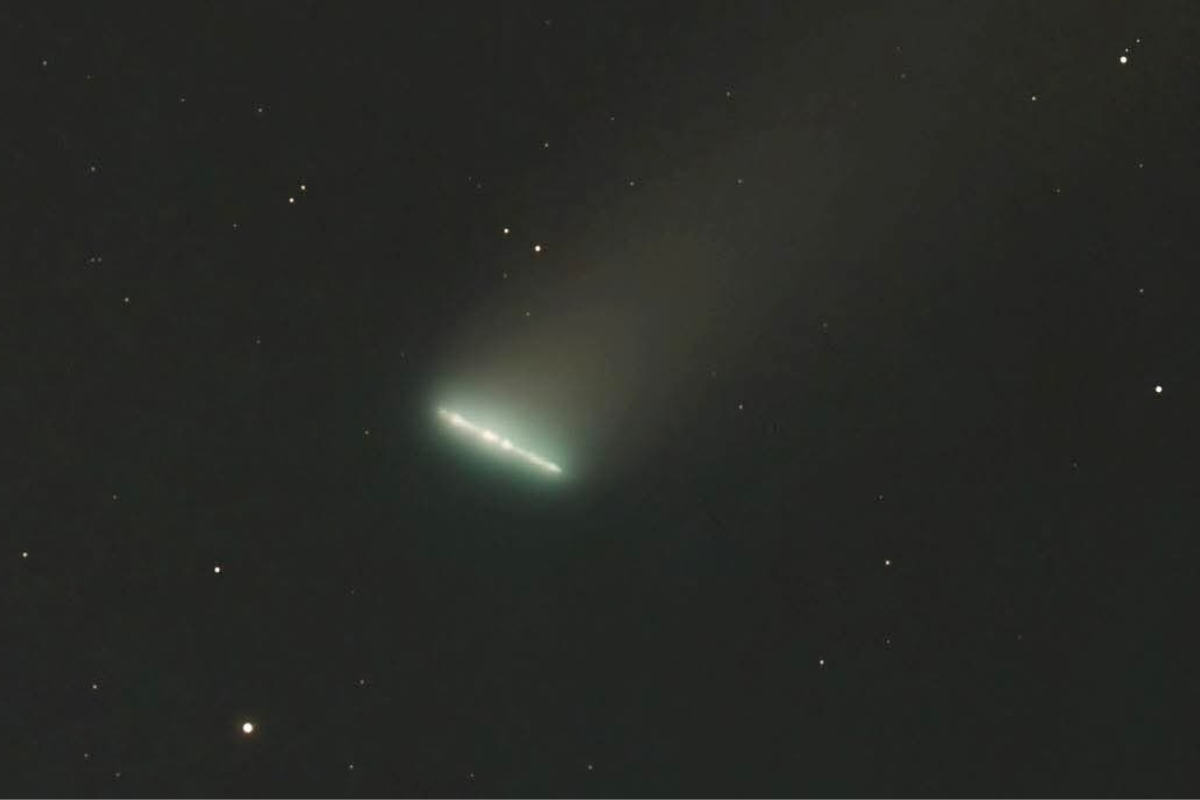Science
Astronomers Stunned by 3I/ATLAS Comet’s Unprecedented Radio Signal

On October 24, 2025, South Africa’s MeerKAT radio telescope detected a remarkable signal from the interstellar comet 3I/ATLAS. This detection marks a significant anomaly in the study of comets, as it produced a narrow-band hydroxyl absorption at frequencies of 1665 and 1667 MHz, commonly referred to as the ‘water hole.’ This frequency range has long been considered crucial in the search for extraterrestrial intelligence, making the discovery even more intriguing.
Historically, radio detections of comets have been rare. In the past fifty years, only about twenty comets have been confirmed through radio observation. Notable examples include Kohoutek, Hale–Bopp, Hyakutake, NEOWISE, and Halley’s Comet. These detections primarily reveal natural processes such as microwave emissions from hydroxyl radicals, thermal noise from cometary comae, or radar reflections that provide insights into the nucleus size and rotation. The Rosetta mission further enhanced this understanding by directly observing comet 67P/Churyumov–Gerasimenko. However, none of these cases exhibited a narrow-band absorption signature like that of 3I/ATLAS.
Understanding the Unusual Signal
The hydroxyl radical typically generates emission lines as comets approach the Sun, with heating increasing activity. In a departure from this norm, 3I/ATLAS registered absorption at these specific frequencies just days before its perihelion, challenging established cometary physics. The specificity of the signal, combined with its location in the water-hole range, has prompted discussions regarding its origins—whether it is a natural phenomenon or indicative of something more.
In contrast to previous interstellar objects such as 1I/ʻOumuamua and 2I/Borisov, which did not exhibit any radio anomalies, 3I/ATLAS stands out by delivering a distinct narrow-band absorption pattern. This is significant, as traditional comets generally produce broad and noisy signals. For scientists, this anomaly could represent an unprecedented discovery in natural comet behavior or hint at the existence of interstellar technology.
Calls for Transparency and Future Observations
Researchers and commentators are urging organizations like NASA, the Jet Propulsion Laboratory (JPL), and the Planetary Defense Coordination Office to release all available data related to this signal, including spectra and high-resolution images. Many in the scientific community believe that the public deserves transparency, especially at a time when they are grappling with the implications of potentially witnessing a new cosmic behavior or signal.
As 3I/ATLAS continues its journey, December 19, 2025, has emerged as a critical date for scientists. They are closely monitoring whether the water-hole frequencies will remain silent or if the signal will reoccur. If the signal is detected again, it could signify one of the most groundbreaking discoveries in planetary science. Conversely, if no additional signals are observed, 3I/ATLAS will still be remembered as a comet that defied expectations and expanded the boundaries of astronomical understanding.
-

 Health2 months ago
Health2 months agoNeurologist Warns Excessive Use of Supplements Can Harm Brain
-

 Health3 months ago
Health3 months agoFiona Phillips’ Husband Shares Heartfelt Update on Her Alzheimer’s Journey
-

 Science4 weeks ago
Science4 weeks agoBrian Cox Addresses Claims of Alien Probe in 3I/ATLAS Discovery
-

 Science3 weeks ago
Science3 weeks agoNASA Investigates Unusual Comet 3I/ATLAS; New Findings Emerge
-

 Science3 weeks ago
Science3 weeks agoScientists Examine 3I/ATLAS: Alien Artifact or Cosmic Oddity?
-

 Science3 weeks ago
Science3 weeks agoNASA Investigates Speedy Object 3I/ATLAS, Sparking Speculation
-

 Entertainment4 months ago
Entertainment4 months agoKerry Katona Discusses Future Baby Plans and Brian McFadden’s Wedding
-

 World2 months ago
World2 months agoCole Palmer’s Cryptic Message to Kobbie Mainoo Following Loan Talks
-

 Entertainment4 months ago
Entertainment4 months agoEmmerdale Faces Tension as Dylan and April’s Lives Hang in the Balance
-

 Science3 weeks ago
Science3 weeks agoNASA Scientists Explore Origins of 3I/ATLAS, a Fast-Moving Visitor
-

 Entertainment4 months ago
Entertainment4 months agoLove Island Star Toni Laite’s Mother Expresses Disappointment Over Coupling Decision
-

 Entertainment3 months ago
Entertainment3 months agoMajor Cast Changes at Coronation Street: Exits and Returns in 2025









